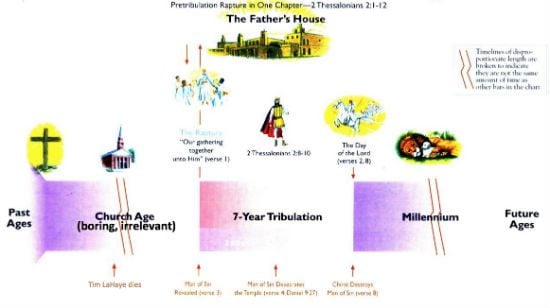The realm of “fan fiction” is one of the few places one can turn to reliably find prose as awful and implausible as the writing of Timothy LaHaye and Jerry B. Jenkins.
I have discovered, googling around, that there exists a sub-subculture of fanfic set in the apocalyptic world of L&J’s “Left Behind” series.
This is not a world I choose to explore. I imagine that the writers of this fanfic are guilty of the same kinds of aesthetic, theological and political sins that L&J commit in their series of novels, and it is tempting to wade in and begin ridiculing the ridiculous there as well.
But one must keep in mind that L&J’s disciples are also their victims. The perpetrators of these fanfic horrors do not have the imperial influence of their masters, nor are they making the tons of money that L&J are reaping from the worst books ever written.
So these poor LB fanfic writers deserve pity, not condemnation. In many versions of the vampire myth, killing the head vampire will free their minions of the curse. The best thing we can do for these poor souls writing LB fanfic is to continue trying to drive a stake through the evil, unbeating heart of their masters.
The sad world of fan fiction does, however, provide some insight into the underlying meaning of the LB series. I am indebted to Teresa Nielsen-Hayden for introducing me to the concept of “Mary Sue” stories. Teresa provides a helpful definition:
MARY SUE (n.): 1. A variety of story, first identified in the fan fiction community, but quickly recognized as occurring elsewhere, in which normal story values are grossly subordinated to inadequately transformed personal wish-fulfillment fantasies, often involving heroic or romantic interactions with the cast of characters of some popular entertainment. 2. A distinctive type of character appearing in these stories who represents an idealized version of the author. 3. A cluster of tendencies and characteristics commonly found in Mary Sue-type stories. 4. A body of literary theory, originally generated by the fanfic community, which has since spread to other fields (f.i., professional SF publishing) because it’s so darn useful. The act of committing Mary Sue-ism is sometimes referred to as “self-insertion.”
This wish-fulfillment and self-insertion pervades Left Behind.
By page 32, where we left off, readers have been introduced to three of the main characters: Rayford Steele, Cameron “Buck” Williams and Hattie Durham. These three are among the surviving passengers on a jumbo jet piloted by Steele that is about to make an emergency landing in Chicago.
Buck Williams is a world-famous, universally admired and envied writer, the Greatest Investigative Reporter of All Time. He’s the perfect fantasy stand-in for Jenkins, a veteran ghostwriter and as-told-to hack whose career up until this series consisted mainly of trying to make other people look good.
Rayford Steele, the mature, commanding presence in the cockpit — graying, but still attractive to women — stands in for LaHaye. (Since Jenkins did the vast majority of the actual at-the-keyboard writing for these books, it’s intriguing to consider whether the portrayal of Steele’s warped sexuality was LaHaye’s own idea, or if it reflects Jenkins’ insights into his more-famous partner.)
And what of Hattie Durham, the servile, “drop-dead gorgeous” flight attendant? She represents, for the authors, a kind of Everywoman. She is sexually attractive and sexually available, and therefore must be punished for arousing naughty sensations in the hearts and loins of our heroes, who alternately hit on this poor woman, then push her away as a means of asserting their virtue and their authority. For the dual sins of being female and attractive, Hattie will soon find herself enslaved by the will of the Antichrist himself.
But I’m gettting ahead of myself. Now, where were we … ?
= = = = = = = = = = = =
P.S.: From the e-mailbag:
Steve S. sent along this link to The Door interview with Jerry Jenkins (sort of).
And I forget who sent this in, but go see Apocamon: The Final Judgement.












